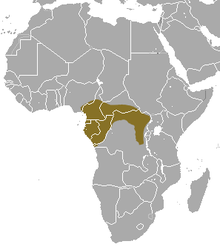Black-footed mongoose
| Black-footed mongoose | ||||||||||||
|---|---|---|---|---|---|---|---|---|---|---|---|---|
| Systematics | ||||||||||||
|
||||||||||||
| Scientific name | ||||||||||||
| Bdeogale nigripes | ||||||||||||
| Pucheran , 1855 |
The black-footed mongoose ( Bdeogale nigripes ), also known as the black-footed mongoose, is a species of predator from the mongoose family (Herpestidae). It lives in the forests of Central Africa, north of the Congo, and feeds mainly on insects and other small animals.
features
The black-footed mongoose is a grayish, relatively light-colored mongoose. However, the eponymous black legs also appear in other mongooses of the genus Bdeogale . The 35–40 cm long tail is white but less bushy than typical of mongooses. With a head-trunk length of 55-65 cm and a body weight of about 2-3.5 kg, the black-footed mongoose is a relatively large species within the mongoose and the largest species of its genus. The upper canines are particularly long and strong in this species.
distribution and habitat
The habitat of the black-footed mongoose are tropical lowland forests west of the African Rift , which they colonize as far as the coast of the Atlantic Ocean and into Nigeria . The species seems to be absent south of the Congo River . The following countries are home to black-footed mongoose populations: Cameroon , Central African Republic , Republic of the Congo , Democratic Republic of the Congo , Equatorial Guinea , Gabon , Nigeria.
food
The black-footed mongoose feeds primarily on ants, especially driver ants ( Dorylus , Myrmecaria ), but also eats other insects, such as snails, crabs and occasionally smaller vertebrates. Occasionally, fallen fruit is also eaten.
Hazardous situation
The black-footed mongoose is considered rare by some scientists, but it seems to be relatively common, especially in the east and south of the distribution area. Overall, populations are declining due to habitat destruction and hunting. Nevertheless, the species is not considered to be endangered (“Least Concern”). The black-footed mongoose can be found in the Okapi National Park ( DRK ) and in the Dzanga Sangha Conservation Area ( ZAR ), for example .
supporting documents
- ↑ a b c Jonathan Kingdon : The Kingdon Field Guide to African Mammals . A&C Black Publishers, London 2007, ISBN 978-0-7136-6513-0 , pp. 257 (first edition: 1997).
- ↑ a b Bdeogale nigripes in the IUCN Red List of Endangered Species . Posted by: Van Rompaey, H., De Luca, D., Rovero, F. & Hoffmann, M., 2008. Retrieved January 27, 2010.
